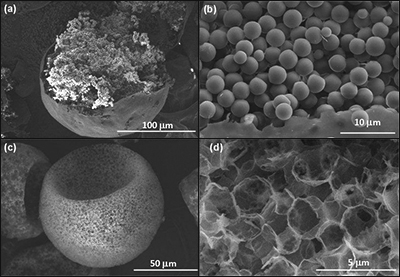News Story
"Pseudo Inverse Opal" Particle Boosts Plastics Production

Professor Kyu Yong Choi.
A technique that uses a unique particle to boost the chemical reactions that generate commercial polymers could greatly improve the manufacturing of common plastics. The patent-pending process was created in the Department of Chemical and Biomolecular Engineering's (ChBE) Polymer Reaction Engineering Laboratory, directed by Professor Kyu Yong Choi.
Silica is a porous material with an extremely high surface area, anywhere from 200m2 to 1000m2 per gram. This makes it ideal for use as an inert, flat substrate (surface) on which to perform high-activity heterogeneous catalytic reactions. In this process the catalyst, which coats the surface of the silica, reacts with a second material to produce a third. Silica's pores provide a large number of sites at which these reactions can occur. When silica is used to create a class of polymers called polyolefins, its pores swell with the new material and they fracture, exposing even more reaction sites, until the silica disintegrates and the reactions end. The technique is used to produce the most important commodity polymers, plastics like polyethylene and polypropylene, but it's not efficient.
"The fragmentation is very irregular and hard to predict," Choi explains. "Sometimes it's incomplete, and you have big pieces of unfragmented silica with a lot of precious catalyst buried inside, wasted. Typically less than 10% of a catalyst is used in these reactions."
But if a new, three-dimensional silica particle developed by his research group is used, Choi says, 80-90% of the catalyst is able to react, increasing product yield and reducing costs. Choi's group developed a polymerization technique that allowed them to create hollow, spherical polymer particles as large as about 100 microns in diameter that contain many nano-sized grains of the same type of polymer—small balls inside of a larger one, or as Choi likes to describe it, something like a pomegranate. This structure serves as the template for the new silica substrate.
To make the 3D substrate, the group creates the same particles, but fills the empty spaces between the nanograins inside with a silica precursor, a material that can be converted to pure silica using a chemical reaction. An acid treatment applied to the polymer particles triggers the reaction, resulting in a silica/polymer composite inside the big, outer sphere. Finally, the particles are put in a furnace. The polymer burns away in a process called calcination, but a pure silica glass remains in the form of the space the precursor had filled--a three-dimensional negative or "inverse" of the original polymer particle.

(a) A pomegranate-like polymer particle that has split open; (b) subparticles, or nano-grains, inside the pomegranate-like particle; (c) a silica PIOS particle after the polymer has been removed, and (d) the cluster of eggshell-like structure inside of a PIOS particle.
The result, says Choi, are novel ultraporous silica nanoparticles, each a cluster of empty eggshells in the approximate shape of the original outer polymer ball. This structure has its own outer shell where the precursor had coated the inside of the outer polymer ball, so thin that the tiny hollow balls inside are visible under a scanning electron microscope. Choi calls these particles pseudo inverse opal silica (PIOS)--they are similar in structure and color as opals--and he says they hold the key to enhanced polymer reaction engineering.
He explains that while the particles provide about the same amount of surface area and pores as their 2D counterparts, their "wide open structure" allows both catalysts and reactants to get to them quickly and easily, instead of being limited to squeezing and in out of only tiny pores. The open regions also allow the product of the reactions, the polymer, to "get out of the way" and expose new reaction sites. The initial reaction rate is extremely high, and more than twice as much polymer is produced than in current industry-standard reactions.
"Not only that," he adds, "but you could also copolymerize your polymer with a bulky, large molecule co-reactant that would normally be very hard to get into the small pores in conventional silica. The PIOS' larger openings give you the possibility of making a polymer with better structure and properties."
Going forward, Choi and his group are hoping to license the technology through the University's of Maryland's Office of Technology Commercialization. They are currently studying the use of PIOSes to manufacture additional kinds of polymers.
For More Information:
Kyu Yong Choi, Carla V. Luciani, Laleh Emdadi, Sang Yool Lee, In Hak Baick, and Jong Sung Lim. "Spherical Pseudo-Inverse Opal Silica with Pomegranate-Like Polymer Microparticles as Templates." Macromolecular Materials and Engineering, 297(10): 1021-1027 (2012) Abstract
Sang Yool Lee and Kyu Yong Choi. "Polymerization of Ethylene over rac-Et(1-indenyl)2ZrCl2/MAO Catalyst Supported on Pseudo-Inverse Opal Silica Particles." Ind. Eng. Chem. Res., 2012, 51 (29): 9742–9749 (2012) Abstract
Published July 15, 2013









